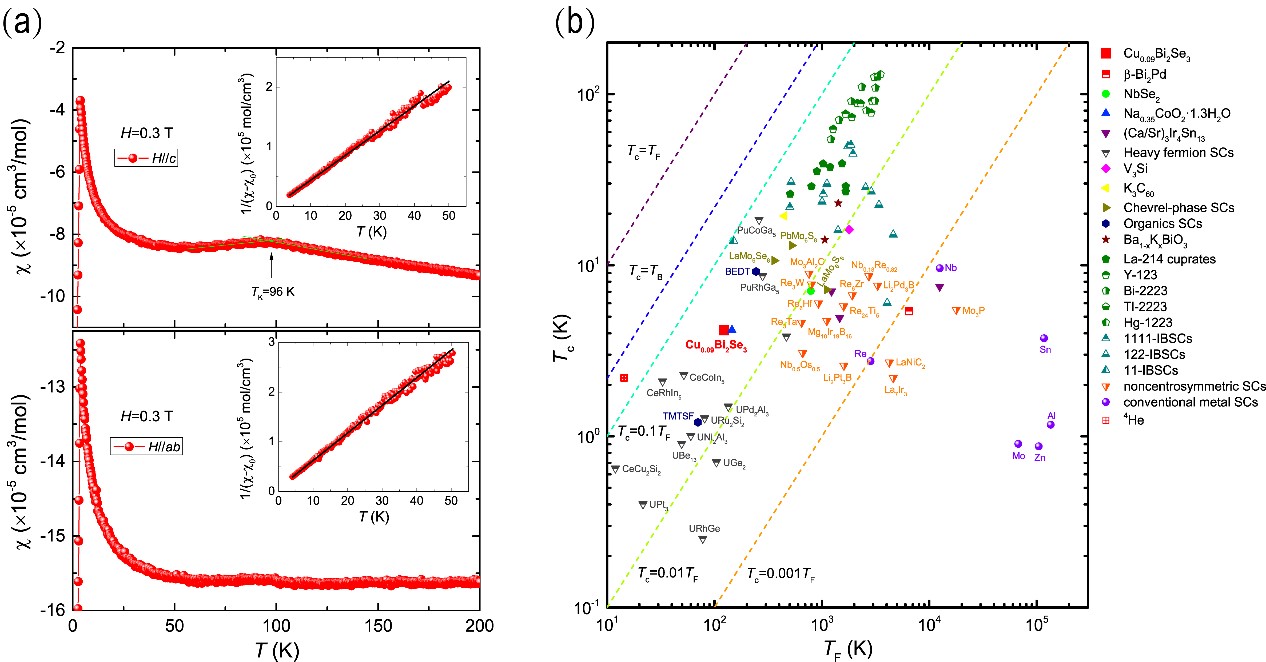Recent years, the search for non-trivial topological materials has become a significant hot topic in condensed matter physics. Since Hor et al firstly reported the discovery of superconductivity in Cu doped topological material Bi2Se3 in 2010, the CuxBi2Se3 has become one of the most promising materials as topological superconductor due to its unique physical properties and crystal structure. However, the superconducting transition temperature Tc up to 3.8 K in CuxBi2Se3 is unexpectedly “high” for a low carrier density semiconductor. So far, the mechanism of such anomalous enhanced Tc phenomenon remains unclear despite nearly a decade of extensive research.
In a recent work led by Shanghai Institute of Optics and Fine Mechanics, Chinese Academy of Sciences, high quality single crystal of CuxBi2Se3 was grown by modified Bridgman method. The Tc of the as-grown crystals with x=0.09 could reach 4.18 K, which was the highest one among reports on CuxBi2Se3 system so far.
A systematic study of the magnetic susceptibility, critical fields, and electrical transport on the Cu0.09Bi2Se3 single crystals were conducted to explore the unusually enhanced Tc and its superconducting properties. Interestingly, a novel kink in the magnetic susceptibility versus temperature was observed at 96 K, which indicated a charge density anomaly, probably charge density wave (CDW) transition.
The analysis of the magnetoelectrical transport at low temperature yielded a high Kadowaki-Woods ratio, which might be enhanced by the charge density instability and/or strong electronic anisotropy. Based on the lower critical field measurement, the energy gap ratio Δ0/kBTC was found obviously larger than the standard BCS value 1.764, suggesting the Cu0.09Bi2Se3 a strong-coupling superconductor. Ratios of both Tc/TF2D and Tc/λ-2(0) fell into the region of unconventional superconductors according to Uemura’s regime, supporting the unconventional superconducting mechanism in CuxBi2Se3.
Their research proposed that the ‘high’ Tc in CuxBi2Se3 arises from the increased density of states at Fermi energy and strong electron-phonon interaction induced by the charge density instability.
The results suggest the higher Tc in CuxBi2Se3 could be further achieved by gating-technique or high pressure technique, as realized in iron-selenides superconductors.

(a). Temperature dependence of magnetic susceptibility under 0.3 T for H//c & H//ab. (Image by SIOM)
(b). Ratio of Tc/TF2D provides the experimental evidence of CuxBi2Se3 as an unconventional superconductor. (Image by SIOM)
Article website:
https://doi.org/10.1088/1367-2630/ab7fca
Contact:
Mr. CAO Yong
General Administrative Office
Shanghai Institute of Optics and Fine Mechanics, CAS
Email: caoyong@siom.ac.cn